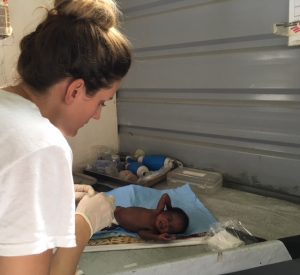Kirsti is a midwife from the USA. She is currently working for MSF / Doctors Without Borders in South Sudan, where she’s helping to ensure women have a safe place to give birth.
My “sister,” Nyapaul, motioned for me to press on her hips in order to alleviate some of the pain from her contraction. She had been in labor for over 24 hours and had made little to no cervical change. The baby’s head, although down, was not engaged in her pelvis. She was on an oxytocin drip that I was watching closely—six drops a minute in her IV. To complicate her clinical picture, she had recently developed an infection.
Providing labor support in the context of South Sudan is difficult because of how many hours I work, and how few hours I sleep. In this case, however, I needed to stay at Nyapaul’s side and ensure that her contractions were strong and frequent. While I was there Nyapaul insisted that with every contraction I kept my hands pressing on her hips, even though her mother was trying to peel them off.
So I sat behind her, with my hands on either side, and with every contraction she reached back and gripped my wrist. I closed my eyes, rested my head on her back, and squeezed. I could see she was worn out but unfortunately I knew we had hours ahead of us.
Her cervical dilation had stalled and I was concerned that she might need a Caesarean section—a procedure that, for so many reasons, is very difficult to do in Lankien. To complicate things, it was Christmas night, the lab was closed, and many of the staff were at home resting, or on the airstrip dancing. I had very little help and with 20 hours of work behind me, I was exhausted.

Image by Kirsti Rinne
After two hours of an oxytocin induction, I rechecked her cervix. No change. She had now been seven centimeters dilated for 12 hours and the baby’s head was showing no signs of descent. I suggested to Judith, my MD backup, that we start the process of preparing for a Caesarean section.
It would take hours to get consent, gather supplies, and wake up the correct staff to help. In those hours, if she progressed—perfect. But if not, then we were ready to take action. Judith agreed, but the patient did not. She wanted to go home to see a traditional healer to help progress labor.
She promised the traditional healer was only going to gently manipulate her abdomen, and she would return within a few hours. I felt like it was a reasonable request, but emphasized how important it was that the traditional healer only touched the outside of her abdomen and did not do anything that was painful to Nyapaul. Facilitating hospital birth here is about empowering women to know that they are in control—particularly because this is a place where women have such little control.
I evaluated a new kala-azar admission and returned to my tukul (a cone-shaped hut common throughout South Sudan) for an hour break before I was called back to the ward. Nyapaul had not been able to find a traditional healer. I was just getting ready to suggest an operative birth when I checked her to find that the two hours of walking had encouraged the fetus to rotate and descend.
I radioed Judith to tell her to rest easy—I was certain Nyapaul was going to deliver vaginally. For two more hours I tried to support her with every contraction, until finally at 2:30 am she delivered a healthy baby girl.

Image by Kirsti Rinne
I was back in the compound, showered, and in bed by 4:00 am. I laid in bed and recounted the events of the night to a friend back home, then fell fast asleep. Reflecting the next day, I realized that Nyapaul’s birth has been my favorite so far. It was the little things that made it so incredible—like the encouragement from every one who saw her pacing the ward (even the cleaner), seeing Nyapaul resting her head on her mother’s lap, and watching Nyapaul and her family open their arms and look at the ceiling for some spiritual support. The details of those images are the ones I want to keep with me.
I spent the rest of the week trying not to miss the details—or to get caught up in the day-to-day stress. On Friday night, several of the expats and I started talking about all of the things that we will look back at and that will make us laugh, like the hedgehog that has taken up residence in Iain’s tukul, or dodging the “shit-storm” from the hundreds of birds that sleep above us in the trees, or ducking the bats that mistakenly fly into the shower at night.
I want to log the details in my mind, because before I know it this experience will be only memories, quite possibly some of my favorite memories. And I want to remember it all.
- My favorite birth - 28th March 2018








Forcing labour very often results in C-section. The use of synthetic hormones to induce birth is unnecessary and frequently produces worse outcomes.